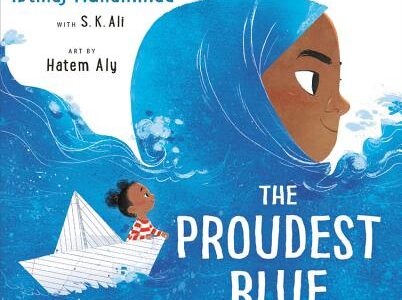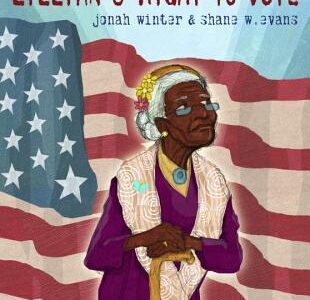Freedom Summer
by Deborah Wiles
“John Henry’s eyes fill up with angry tears. “I did,” he says. “I wanted to swim in this pool. I want to do everything you can do.”
This books highlights the genuine friendship between two boys, one Black and one White, in the the South in 1964. The author and illustrator do a great job of depicting the bond these boys share while also expressing the challenges they face and emotions created as a result. It is also a wonderful example for your children of what it means to truly be anti-racistA person who's beliefs, words, and actions show a commitment to being against racism. It includes believing that all racial groups are equals as well as thinking of and supporting changes in any rule that does not treat all groups fairly. More.
Talk About It
- On the very first page we see images of the boys as they are about to greet one another. What do you notice? What do you think they’re feeling? Do you think they are focused on one another’s skin color in this moment? Do you think they are aware of the differences between them? This is a great moment to talk about that everyone notices skin color…it’s part of what makes up the way someone looks. However, the boys do not use that to decide how they feel about one another.
- Why is John Henry not allowed at the town pool? Explain segregationSeparating one group of people from another; often based upon race. Segregation happens when a society views one group of people as better than another. The goal is to keep the "lesser" people away from the "superior" group. This is often done by treating the other group poorly and denying them basic civil rights. More to your child. Do the boys let this stop them from enjoying playing together? Do either of the boys’ parents prevent them from playing together?
- Notice the way each boy’s unique skin color is used as a tool for description; each beautiful in its own way.
- What do you think about John Henry not being allowed in to the store? How do you think this makes each of the boys feel? Share your own thoughts, focusing on the fact that multiple thoughts and feelings can happen simultaneously.
- What do you think the boy was thinking and feeling when his mama told him about the town ending segregationSeparating one group of people from another; often based upon race. Segregation happens when a society views one group of people as better than another. The goal is to keep the "lesser" people away from the "superior" group. This is often done by treating the other group poorly and denying them basic civil rights. More? Where do you think he was headed when he jumped up from the table?
- Look at the boys’ faces as John Henry announces he’s going to be able to swim in the town pool. What are they feeling?
- How did their feelings change when they got to the pool only to find that it was closed? Why do you think the pool was being filed in? Explain to your child that strategies like this were often utilized to avoid desegregationEnding rules or actions that separate people of different races. In the United States this meant getting rid of things like separate bathrooms or water fountains for Black and White people. It also made it not okay to refuse to let a Black person do things like stay at a hotel or eat in restaurant. More. What do they think about the fact that even when it was illegal, White people continued to discriminate against Black people? Is it ever okay to view yourself as better than someone because of things like skin color, clothing, hair, etc?
- The boys sit on the diving board and have an honest and hard conversation. Why do you think John Henry is described as crying “angry tears?” How do you think it made him feel to have his friend quietly listen and then share all the things he wants them to do together? Do you think John Henry should be allowed to do the same things as White children?
- What do you think and feel when the boys decide to enter the store together? Talk to your child about how it makes you feel to see the narrator character being such a loyal friend. Explain that this is what it looks like to be an allyA person willing to speak up or simply stand next to someone else (or a group of people) when they are being treated unfairly. An ally is also committed to learning and understanding more in order to help create changes. More and act in an anti-racistA person who's beliefs, words, and actions show a commitment to being against racism. It includes believing that all racial groups are equals as well as thinking of and supporting changes in any rule that does not treat all groups fairly. More manner.
- Why do you think the author chose to end the story here instead of following the boys into the store? Do you think it matters what happened inside or is it more important to see the way they are navigating the world together?
Explore More
- In order to give context to the book title, spend time talking about Freedom SummerWork done during the summer of 1964 to increase the number of Black men and women in Mississippi signed up to vote. Over 700 White people volunteered alongside Black volunteers to fight against rules and mean actions used to keep Black people from voting. More. To learn more check out Zinn Education Project: Freedom Summer 1964; Freedom Summer Sourcebook; Freedom Summer; and 14 Books for Children and Teens About the Freedom Summer of 1964.
- The author uses the power of words to showcase the beauty that exists within someone’s skin color. Think about people you know or grab one of your favorite diverse books and create your own beautiful descriptions. Talk about any changes you experience during this process in how you think about skin color or raceWhen people are grouped based upon certain physical characteristics; most commonly skin color. More. Moving forward, do you think there are better ways to describe someone that just white, black, or brown?
- Talk about the fact that Black people still face many forms of segregationSeparating one group of people from another; often based upon race. Segregation happens when a society views one group of people as better than another. The goal is to keep the "lesser" people away from the "superior" group. This is often done by treating the other group poorly and denying them basic civil rights. More, even in things as simple as the schools they attend. Watch the video Kids Talk About Segregation . What does your child think about this video? Talk about your child’s school and ask questions about the amount of diversityThis word simply means differences. It generally refers to differences in things like race, gender, religion, language, culture, or appearance. More in their class and how much do all of the kids really engage with one another both in the classroom and out at recess. Think together about ideas for how to improve diversityThis word simply means differences. It generally refers to differences in things like race, gender, religion, language, culture, or appearance. More within your school. Think about ideas for helping students of all different races really get to know one another and spend time together. Make a list of your ideas. Talk to your child about the possibility of sharing these thoughts with school staff.
- It is also important to talk about how your child can be a good friend, allyA person willing to speak up or simply stand next to someone else (or a group of people) when they are being treated unfairly. An ally is also committed to learning and understanding more in order to help create changes. More, and anti-racistA person who's beliefs, words, and actions show a commitment to being against racism. It includes believing that all racial groups are equals as well as thinking of and supporting changes in any rule that does not treat all groups fairly. More in both their 1:1 interactions with others and in group settings. Role play things your child might say or actions they might take if they see a student being discriminated against because of something they cannot control like skin color or clothing. (It will be much easier for them to take action when on their own if they feel confident about knowing what to say or do.)
- For parents: Think about your friendships and your family’s social network. Is it diverse? If not, spend time looking for ways to expand your circle by joining community activistSomeone who feels so strongly about an issue (like racial equality or ending bullying) that they are willing to take action to make a change. Activists spend time and energy learning more about a topic and sharing that knowledge with others. Activists speak up when they notice someone or something being treated unfairly. More groups or taking courses at an art studio, cooking school, community center, etc in a more diverse part of your city.




